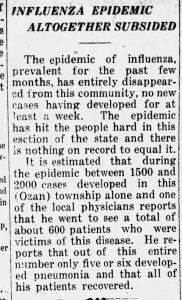The Spainish Flu…An Epidemic Hits Hempstead County 100 Years Ago
By Josh Williams, 04/20/20 9:24 PMOver the last few weeks, we have been dealing with the implications of a new virus and its impact on the public health. For many of us, we don’t remember dealing with something like this within our living memory. A similar event though, has happened before in our local history. In the Fall of 1918, the United States and Hempstead County dealt with another public health crisis with the Spanish Flu. Some of you may remember family members that survived or died from this particular flu. My grandmother, Polly Williams, had a sister that died of the Spanish flu at a very young age.
The Spanish Flu epidemic hit the United States in 1918 and continued with different spikes on into 1920. It spread worldwide killing at least 22 million people. In Arkansas, it claimed around 7,000 lives that were documented. Hempstead County was not immune to this health crisis. By late September, cases began to show up in Arkansas and around the state. In response, the Director of the Arkansas Board of Health, Dr. Charles Garrison, issued a statewide quarantine on October 8, 1918. The quarantine cancelled all schools including universities, church meetings, movie theaters, music classes, and any other types of indoor activities, such as pool halls.
When the quarantine was issued the Star of Hope newspaper already declared in its October 9 issue that “There is quite a number of cases in Hope, but it is thought there is no occasion for alarm, as all necessary precautions will be taken to prevent its spread.” Children under 18 were required to stay at home and quarantined to their homes and back yards. The flu spread the quickest along the towns located along major transportation routes such as the railroads. Towns like Fort Smith, Little Rock, Hope, and Memphis were all places that saw higher amount of cases of the flu. The Washington Telegraph newspaper reported that in early October there were several hundred cases in Hope alone.
Various civic groups canceled or postponed their regular meetings including the local Rotary Club of Hope. A meeting of the local Union Baptist Association that was to meet in Patmos announced they would postpone the meeting until November “on account of an epidemic of Spanish Influenza, [and] the State Board of Health has placed Arkansas under a strict quarantine under which all public gatherings are prohibited.”
Even though Hope had the most cases, the rest of Hempstead County was not immune from the virus. The Washington Telegraph newspaper noted several cases up in the northern part of the county around McCaskill and Ozan. Washington itself had over 100 cases in the month of October 1918 alone. Local physicians in Columbus area such as Dr. J.R. Autrey and H. H. Darnall were busy trying to care for the different families of the county. Dr. Autrey fell ill to the flu himself and Dr. Darnall received 60 calls in just one morning for treating the flu.
Of course, different local residents died from the flu. It was reported that James, the son of Mr. B. H. Irvin of Ozan died. He was 3-1/2 years old. A shocking death reported by the Washington Telegraph was the death of local resident and merchant, Sterling O. Gold. Gold was the son of the Methodist Minister and mercantile owner, John H. Gold. He fell sick with the flu on Saturday, October 12 and within one week he was dead. He was 32 years old and was survived by his wife, Ella Frazier and their newborn baby girl.
The local chapter of the Red Cross and the Board of Health continued to send out reminders to people to not gather in large groups and to cover their mouths when they sneeze and cough including recommendations of wearing masks. The Washington Telegraph printed a reminder of being a good neighbor that read “It is not a neighborly act to go out and spread the disease among the people . . . be neighborly and treat others as you would like to be treated and it will be much better for all.”
By the beginning of November cases began to decrease and the state quarantine was lifted after 6 weeks leaving local quarantine rules up to each county. Beryl Henry, principal of Hope High School returned to Hope when school started back on November 4. Even though the quarantine was lifted there were still some restrictions asking for children not to attend church services and for pool halls to be limited to only players and not large groups of observers.
By January, flu cases once again increased in Hempstead county and continued at different times throughout 1919 and into 1920. A county and statewide quarantine was not put back in place, but reminders were given out reminding residents to be mindful of their distance and congregating in large groups in order to prevent spread of the flu and reissuing of the statewide quarantine.
Today we are dealing with a different virus that is being studied to learn more about its dynamics. To help safeguard public health they are implementing similar quarantine rules and guidelines. At the same time, previous generations of Hempstead County residents have gone through similar quarantines and concerns. Lest we forget.
To see some original articles about this event visit the Facebook page of the Hempstead County Historical Society @HempsteadCountyHistoricalSociety. For more information feel free to email us at hempsteadhistory@gmail.com.




